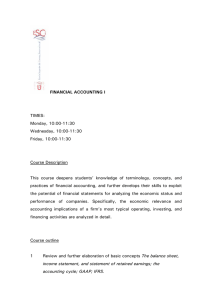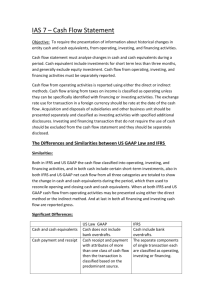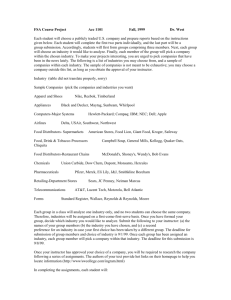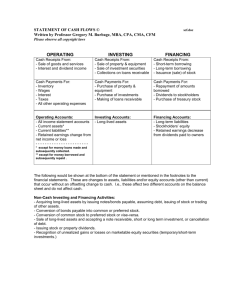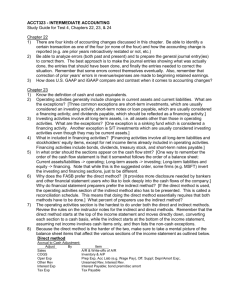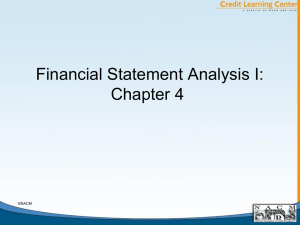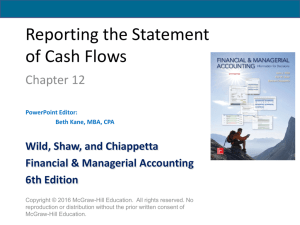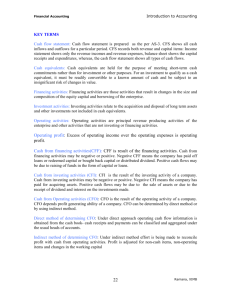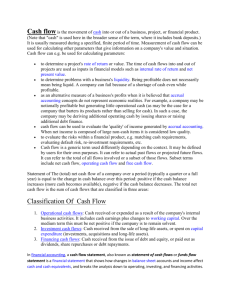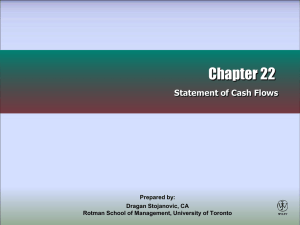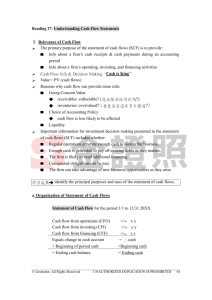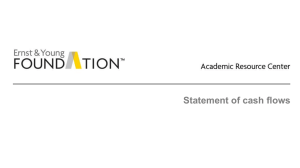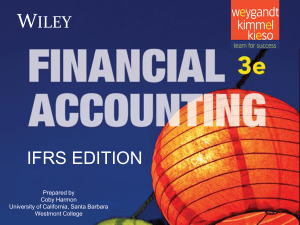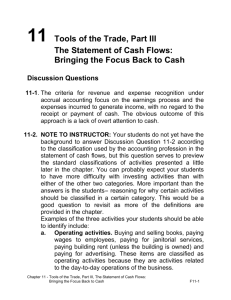STUDY SESSION 7 FINANCIAL STATEMENT ANALYSIS
advertisement
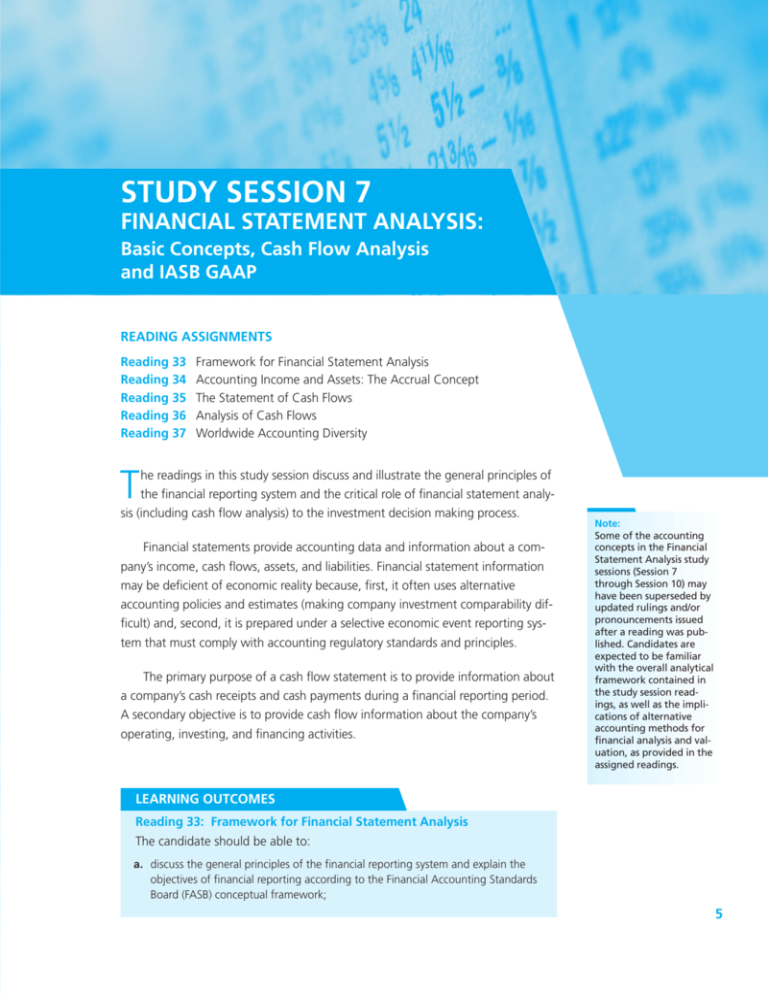
STUDY SESSION 7 FINANCIAL STATEMENT ANALYSIS: Basic Concepts, Cash Flow Analysis and IASB GAAP READING ASSIGNMENTS Reading 33 Reading 34 Reading 35 Reading 36 Reading 37 Framework for Financial Statement Analysis Accounting Income and Assets: The Accrual Concept The Statement of Cash Flows Analysis of Cash Flows Worldwide Accounting Diversity T he readings in this study session discuss and illustrate the general principles of the financial reporting system and the critical role of financial statement analysis (including cash flow analysis) to the investment decision making process. Financial statements provide accounting data and information about a company’s income, cash flows, assets, and liabilities. Financial statement information may be deficient of economic reality because, first, it often uses alternative accounting policies and estimates (making company investment comparability difficult) and, second, it is prepared under a selective economic event reporting system that must comply with accounting regulatory standards and principles. The primary purpose of a cash flow statement is to provide information about a company’s cash receipts and cash payments during a financial reporting period. A secondary objective is to provide cash flow information about the company’s operating, investing, and financing activities. Note: Some of the accounting concepts in the Financial Statement Analysis study sessions (Session 7 through Session 10) may have been superseded by updated rulings and/or pronouncements issued after a reading was published. Candidates are expected to be familiar with the overall analytical framework contained in the study session readings, as well as the implications of alternative accounting methods for financial analysis and valuation, as provided in the assigned readings. LEARNING OUTCOMES Reading 33: Framework for Financial Statement Analysis The candidate should be able to: a. discuss the general principles of the financial reporting system and explain the objectives of financial reporting according to the Financial Accounting Standards Board (FASB) conceptual framework; 5 6 Note: For purposes of the Level I Examination, candidates should assume that U.S. GAAP (Generally Accepted Accounting Principles) applies unless otherwise noted. Study Session 7 b. identify the two primary qualities of accounting information (i.e., relevance and reliability), the ingredients of relevance (i.e., predictive value, feedback value and timeliness), the ingredients of reliability (i.e., verifiability, neutrality and representational faithfulness), the two secondary qualities of accounting information (i.e., comparability and consistency), and discuss how these qualities provide useful information to an analyst; c. describe and explain the purposes of the five principal financial statements (i.e., Balance Sheet, Income Statement, Statement of Comprehensive Income, Statement of Cash Flows and Statement of Stockholders’ Equity) and discuss the additional sources of information accompanying the financial statements, including the financial footnotes, supplementary schedules, Management Discussion and Analysis (MD&A) and proxy statements; d. discuss the role of the auditor and the meaning of the audit opinion. Reading 34: Accounting Income and Assets: The Accrual Concept The candidate should be able to: a. describe the format of the income statement and discuss the components of net income; b. describe the criteria for revenue and expense recognition and discuss major issues in revenue and expense recognition including the affect on reported earnings and their implications for financial analysis; c. compare the percentage-of-completion method with the completed contract method and contrast the effects of the two methods on the income statement, balance sheet, statement of cash flows and selected financial ratios; d. describe the types and analysis of unusual or infrequent items, extraordinary items, discontinued operations, accounting changes, and prior period adjustments; e. discuss managerial discretion in areas such as classification of good news/bad news, income smoothing, big bath behavior and accounting changes, and explain how this discretion can affect the financial statements; f. describe the format and the components of the balance sheet and the format, classification, and use of each component of the statement of stockholders’ equity. Reading 35: The Statement of Cash Flows The candidate should be able to: a. identify the principal purposes and uses of the statement of cash flows; b. compare and contrast the three major classifications (i.e., cash provided or used by operating activities, investing activities, and financing activities) in a statement of cash flows, and describe how noncash investing and financing transactions are reported; c. calculate and analyze, using the indirect method, the net cash flow provided or used by operating activities, investing activities and financing activities. Study Session 7 Reading 36: Analysis of Cash Flows The candidate should be able to: a. classify a particular transaction or item as cash flow from 1) operations, 2) investing, or 3) financing; b. compute and interpret a statement of cash flows, using the direct method and the indirect method; c. convert an indirect statement of cash flows to a direct basis; d. explain the two primary factors (i.e., acquisitions/divestitures and translation of foreign subsidiaries) that may cause discrepancies between balances of operating assets and liabilities reported on the balance sheet and those reported in the cash flow statement; e. describe and compute free cash flow; f. distinguish between U.S. GAAP and IAS GAAP classifications of dividends paid or received and interest paid or received for statement of cash flow purposes. Reading 37: Worldwide Accounting Diversity and International Standards The candidate should be able to: a. discuss the factors influencing and leading to diversity in accounting and reporting practices throughout the world and explain why worldwide accounting diversity causes problems for capital market participants; b. discuss the importance of the hierarchical model of accounting diversity; c. discuss the arguments for and against harmonization and discuss the role of the International Accounting Standards Board (IASB). 7
